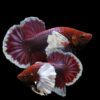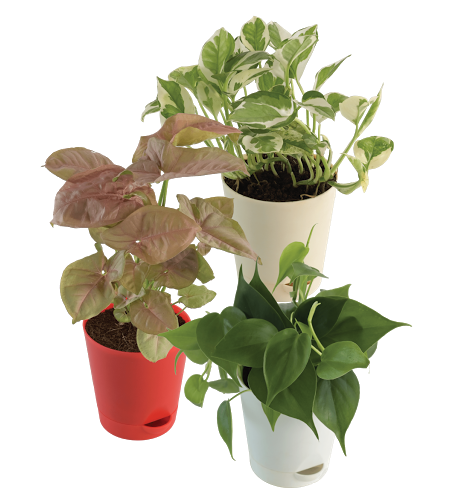Salvinia auriculata is a cosmopolitan floating fern that grows quickly if given enough nutrition and light. Light leaves indicate a lack of micronutrients. It tends to block light from reaching the plants at the bottom. Small hairs on the leaves of Salvinia varieties make them water resistant. By shading parts of the aquarium and utilising nutrients in the water, it aids in the prevention of algae. Grows very large in the wild and under ideal conditions. An ornamental plant for open aquariums. Salvinia natans is the common name for this lovely floating fern. It does not, however, belong to S. natans, but to the Salvinia auriculata species group, which is native to tropical America. Because of its geminate ovoid floating leaves, this fast-growing floating plant is highly decorative, especially in open tanks. Because it grows quickly, it reliably removes excess nutrients from the water. It is especially suitable for breeding tanks because its rootlike finely split underwater leaves provide excellent hiding places for fish fry.
The Salvinia auriculata species group of floating ferns originated in tropical America but have since spread to other parts of the world. S. auriculata, S. biloba, S. herzogii, and S. molesta are members of this species group (agg. = “aggregate”).
Floating fern sold as “Salvinia natans” is actually Salvinia auriculata, not Salvinia natans, an annual species found in Europe, North Africa, and Asia.
Salvinia auriculata is a floating aquatic fern that can be used to decorate fish and shrimp tanks. This plant requires little care because it is hardy and adaptable to a wide range of water conditions.
Salvinia auriculata is notable for its rapid growth rate and requires only abundant nutrients and lighting to grow vigorously and spread dense green mats on the water’s surface.
In this article, we will show you how to grow, maintain, and care for Salvinia auriculata in your aquarium.
Salvinia Auriculata’s Origin and Taxonomy:
Salvinia auriculata is a species of aquatic plant also known as African payal, Butterfly fern, and Eared watermoss.
Salviniaceae is a family of Heterosporous ferns in the order Salviniales. This fern family is made up of two genera: Azolla and Salvinia. Salvinia auriculata is a species of Salvinia, which was named after Anton Maria Salvini, a 17th-century Italian scientist. The genus contains 12 known species, all of which have very similar morphologies.
Salvinia Auriculata’s Habitat:
Salvinia auriculata is native to tropical America, where it is currently prevalent in Argentina, Bolivia, Brazil, Colombia, Costa Rica, Ecuador, El Salvador, Honduras, Mexico, Panama, Paraguay, Peru, and Venezuela.
This species has been introduced and is now found as an ornamental plant in other parts of the world.
This free-floating fern lives in still and slow-moving bodies of water such as lakes, ponds, rivers, marshes, swamps, ditches, reservoirs, and rice fields.
The factory is fiercely competitive! It is capable of displacing native plants and animals, growing quickly, and blocking canals and waterways. Furthermore, Salvinia auriculata is classified as an invasive species in Cuba, the Dominican Republic, Taiwan, Zambia, and Zimbabwe. It thrives in nutrient-rich warm water and can withstand mild temperate temperatures, occasional frost, and low salinity levels.
Salvinia auriculata description:
Salvinia auriculata is a perennial floating fern with abundant horizontal shoots. This aquatic plant’s colour ranges from bright green to olive-green. It has many leaves that are arranged in three whorls. Two of these three leaves float (often 1 – 3 cm or 12 – 1 inch in size), while the third remains submerged. The floating leaves are densely covered with fine protective, egg-beater shaped hairs, and the third leaf in each whorl is modified to form a 1 – 2 inch finely divided root structure (2.5 – 5 cm). Depending on the environmental conditions, the plant’s morphology or growth forms change. There are three types of growth: primary, secondary, and tertiary. The primary form’s floating leaves are flat, well-spaced, oval, and have slightly lobed bases. The leaves of the tertiary form, on the other hand, are densely crowded and tightly folded upwards along the mid-vein, whereas the floating leaves of the secondary form are intermediate between the primary and tertiary forms.
Salvinia auriculata has no true roots and relies on the hair-like projections of its submerged leaves to act as roots. The submerged leaves also have sporocarps, which are spore-producing structures.
Note: This plant is sometimes confused with Salvinia natans, which is not commonly used in the aquarium hobby because it is an annual plant.
Tank specifications and water parameters:
Tank dimensions:
Because Salvinia auriculata floats on the water’s surface, it can be kept in tanks of varying sizes and depths.
It grows quickly and takes up a lot of space under ideal conditions. Keep in mind that even a single plant can quickly cover a 20-inch tank. As a result, I would keep them in at least a 10 gallon (40 L) tank.
Temperature, hardness, and pH of the water:
Temperature: This species prefers temperatures ranging from 71 to 80 degrees Fahrenheit (22 to 26 degrees Celsius). Keep in mind that the faster the Salvinia grows and the larger its leaves become, the warmer the water.
pH: It can grow in a wide pH range, but the optimal pH is between 6.0 and 8.0.
Salvinia auriculata does not care about hardness in general. It can easily withstand both soft and hard water. Maintain water hardness in the range of 3 – 18 GH for optimal growth and development of this plant species.
Lighting:
Salvinia auriculata can grow in light conditions ranging from moderate to high. It requires bright light to grow quickly and sprout new shoots. The plant’s growth rate will slow down in low-light conditions. A LED light can provide bright lighting, and the lights should be turned on for at least 10 hours per day. This plant grows in open ponds, lakes, swamps, and other areas with little shade. As a result, direct sunlight is best for this plant. However, this is not ideal for aquariums containing other plant and animal species that may not tolerate direct sunlight or a very powerful artificial high light. So we have to strike a balance here.
Flow of water:
Duckweed lives in ponds and shallow streams with slow-moving currents in its natural habitat. They frequently die in fast-moving water (0.3 m/sec). As a result, tanks housing this plant should have still / slow water currents.
Fertilization and CO2:
CO2 injection is not required. Salvinia auriculata does not require CO2 dosing because it obtains it from the environment. External fertilisers, on the other hand, are not the same. The floating plant absorbs a large portion of the required nutrients from the water. As a result, the use of fertilisers in the water column would be greatly appreciated. Regular fertiliser application increases yield and results in a healthier overall appearance. So, if you want to boost its growth, you should provide fertilisers (NPK- Nitrogen, Phosphorus, and Potassium) or supplements on a regular basis.








